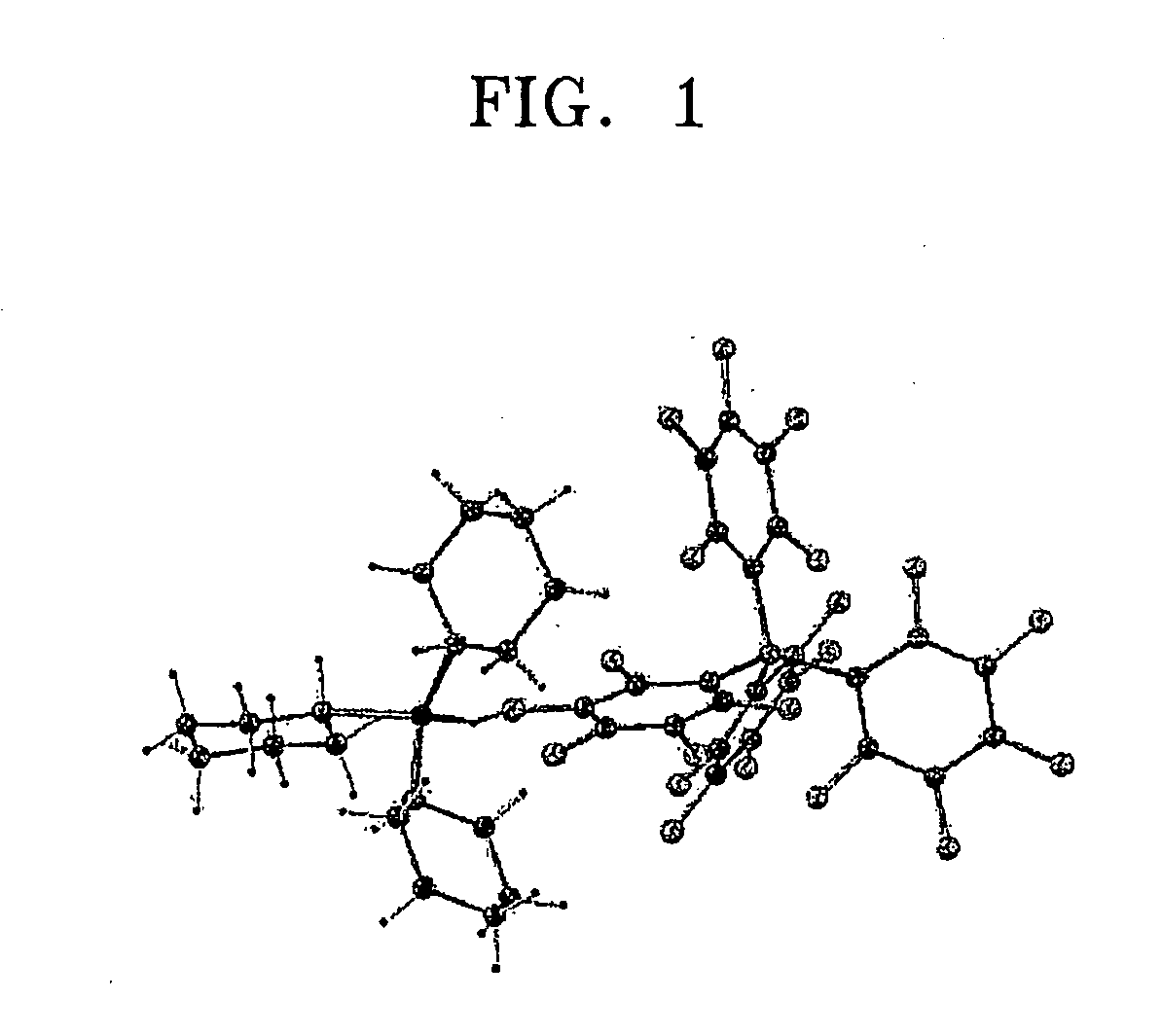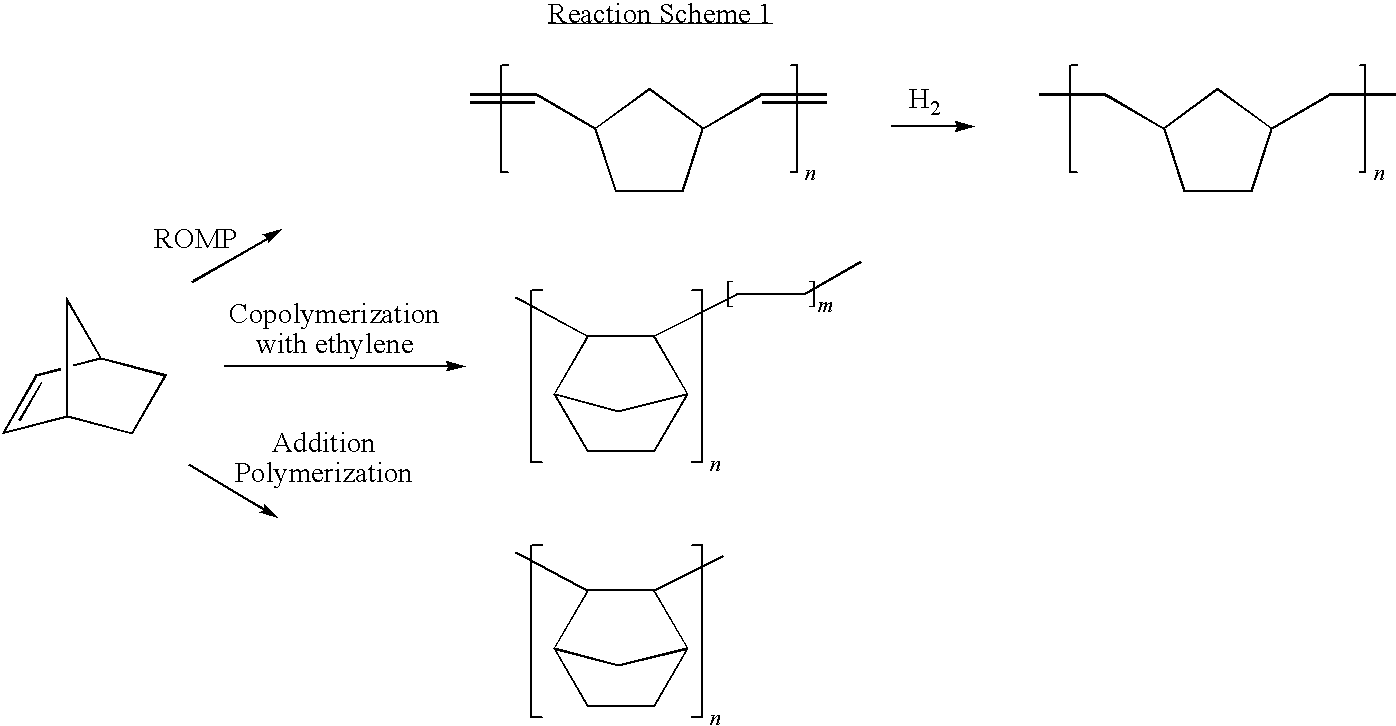Method of producing cyclic olefin polymers having polar functional groups, olefin polymer produced using the method and optical anisotropic film comprising the same
a technology of cyclic olefin and polymer, which is applied in the field of producing cyclic olefin polymers, can solve the problems of poor thermal and oxidative stability of polymer, increased cost due to additional processes, and deterioration of copolymer impurities, and achieves high yield
- Summary
- Abstract
- Description
- Claims
- Application Information
AI Technical Summary
Benefits of technology
Problems solved by technology
Method used
Image
Examples
preparation example 1
Preparation of (Cy)3PHCl
[0082](Cy)3P (2.02 g, 7.2 mmol; Cy=cyclohexyl) was dispersed in Et2O (150 mL) in a 250 mL Schlenk flask. Then, anhydrous HCl (14.4 mL, 1.0 M in ether) was added to the solution at room temperature to give a white solid. After stirring for about 20 minutes, the solid was filtered through a glass filter and washed three times with Et2O (80 mL). Thereafter, the residual solvent was removed at room temperature in vacuum to obtain (Cy)3PHCl (86%, 1.95 g).
[0083]1H—NMR (600 MHz, CD2Cl2): δ7.02˜6.23 (d, 1H, JH—P=470 Hz), 2.56˜1.30 (m, 33H); 13C—NMR (600 MHz, CD2Cl2): δ28.9 (d), 28.5 (d), 26.8 (d), 25.6 (s). 31P—NMR (600 MHz, CD2Cl2): δ 22.98 (d, JP—H=470 Hz).
preparation example 2
Preparation of (n-Bu)3PHCl
[0084]Bu)3P (2.0 g, 10.0 mmol, n-Bu=n-butyl) was dispersed in Et2O (100 mL) in a 250 mL Schlenk flask. Then, anhydrous HCl (20.0 mL, 1.0 M in ether) was added to the solution at room temperature to give a white solid. After stirring for about 20 minutes, the solid was filtered through a glass filter and washed three times with Et2O (80 mL). Thereafter, the residual solvent was removed at room temperature in vacuum to obtain (n-Bu)3PHCl (90%, 2.15 g).
preparation example 3
Preparation of [(Cy)3PH][B(C6F5)4]
[0085][Li][B(C6F5)4] (1.0 g, 1.46 mmol) was suspended in CH2Cl2 (20 mL) in a 100 mL Schlenk flask and the CH2Cl2 (20 mL).solution of (Cy)3PHCl (0.56 g, 1.75 mmol) prepared in Example 1 was slowly added. After stirring for 1 hour, the resulting slurry was filtered to yield a dark yellow filtrate and the solvent was removed in vacuum to obtain tricyclohexylphosphonium(tetrakispentafluorophenyl)borate[0086][(Cy)3PH][B(C6F5)4] (90%, 1.26 g).
[0087]1H—NMR (600 MHz, CD2Cl2): δ5.32˜4.65 (d, 1H, JH—P=440 Hz), 2.43˜1.33 (m, 33H); 13C—NMR (600 MHz, CD2Cl2): δ149.7, 148.1, 139.7, 139.2, 138.1, 138.0, 137.8, 136.2, 125.1, 124.9, 29.0, 28.8, 26.7 (d), 25.4 (S). 31P—NMR (600 MHz, CD2Cl2): 31.14 (d, JP—H=440 Hz). 19F—NMR (600 MHz, CD2Cl2): −130.90, −161.51, −163.37.
[0088]Crystals suitable for an X-ray diffraction study were grown from dichloromethane solution. The result of an X-ray crystal structure determination is presented in FIG. 1. Interestingly, the structur...
PUM
| Property | Measurement | Unit |
|---|---|---|
| temperature | aaaaa | aaaaa |
| thickness | aaaaa | aaaaa |
| Tg | aaaaa | aaaaa |
Abstract
Description
Claims
Application Information
 Login to View More
Login to View More - R&D
- Intellectual Property
- Life Sciences
- Materials
- Tech Scout
- Unparalleled Data Quality
- Higher Quality Content
- 60% Fewer Hallucinations
Browse by: Latest US Patents, China's latest patents, Technical Efficacy Thesaurus, Application Domain, Technology Topic, Popular Technical Reports.
© 2025 PatSnap. All rights reserved.Legal|Privacy policy|Modern Slavery Act Transparency Statement|Sitemap|About US| Contact US: help@patsnap.com



